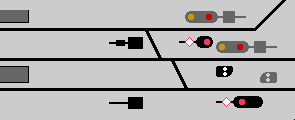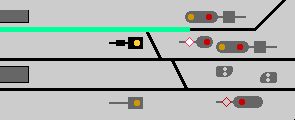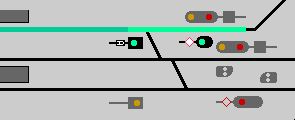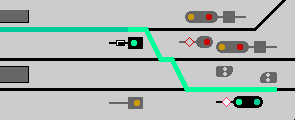![]()
Exit Route Signals basically have the sole purpose of informing trains from which track, if any, a train may depart. An Exit Route Signal is not a Main Signal, i.e. it cannot show "Stop". An incoming train is not required to stop short of an Exit Route Signal regardless of its indication, as are switching moves not required to observe Exit Route Signals. A train may, however, not depart without having been permitted to do so by the Exit Route Signal.
An Exit Route Signal is typically placed at the end of a Platform Track (Danish: Perronspor), i.e. a Station track that can hold a train being stopped for operational purposes like exchange of passengers, a meet or to be overtaken. A platform track need not actually have a platform to fit the definition:

An Exit Route Signal may physically be located almost anywhere, as long as it is visible from the Platform Track. In some cases (curved tracks for instance) Exit Route Signals were placed within the platform track. The length of the platform track is limited by the Clearance Limit Markers, i.e. the clearance at the switches at the ends of the track, not by the location of the Exit Route Signal. The signal would repeat its aspect from the rear side of the signal, thus making it possible for an engineer with a train already past the signal to look back and still read the signal. Yellow light is repeated from the rear as yellow, green light is repeated as blue:

In case of bad visibility, the Exit Route Signals can be duplicated along a platform track. The duplication serves only to repeat the outermost Exit Route Signal . The signals will show the exact same aspects at any time:


Signals equipped for repeating their aspect from the rear of the signal often have a somewhat larger background plate. Below is shown one variation, front and back sides respectively:


Exit Route Signals may have a supplemented Route Destination Indicator:

 |
 |
|
|
X | X |
 |
 |
|
|
X | X |
|
X | X |
|
X | X |
|
X |


Exit Route Signals may be combined with Dwarf Signals on stations with Switching Routes; examples of their use below. Still the Exit Route Signals may be located away from their tracks:




Given the technology and functional requirements of the time of origin, there is no differentiation between the entry route and the safety overlap. They are both part of the same locking. When Dwarf Signals are used with Exit Route Signals, the Dwarf Signal at the end of the platform track will normally not permit the train to proceed. Though there may still be no technical difference between entry route and safety overlap, matters are more blurred. The Dwarf Signal at the end of a Platform Track, i.e. at the "normal stopping location", now marks the end point of the entry route:


Not all entry routes extends to the Switch Limit. Routes ending elsewhere (i.e. in a tail track) are considered more hazardous that the normal entry routes ending at the Switch Limits. Among the precautions to be taken are to mark the latest permitted stopping point for an incoming train by the sign "Stop". The track behind the "Stop" sign thus serves as a safety overlap:






The example below shows a Station, from which it is possible to proceed onto a single track line (top) and a double track line (bottom). Since exit to both lines is only possible from track 1 (top), only the Exit Route Signal in track 1 is equipped with a Route Indicator:

Entry Routes will typically extend to the Switch Limits on the same track where possible:

When exit routes are set and the Exit Route Signal shows "Route Set", the Route Indicator indicates the line that the train is routed towards:





Some older interlockings dating from before the Platform Exit Signal have later been added similar Platform Exit Signals, but to be used as end points for short entry routes without safety overlap.
As most of these mixed interlockings have either been replaced, or the
Exit Route Signals converted to Platform Exit Signals, this mixed signal
configuration is no longer in use.
![]()
| [Back] | [Home] |
![]()